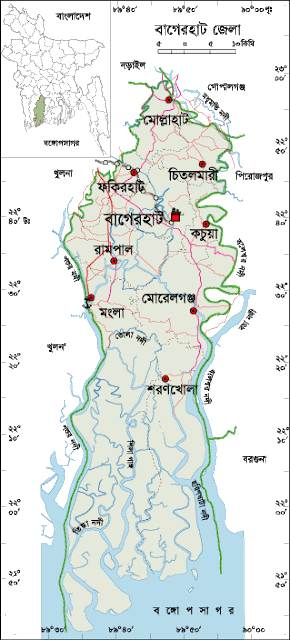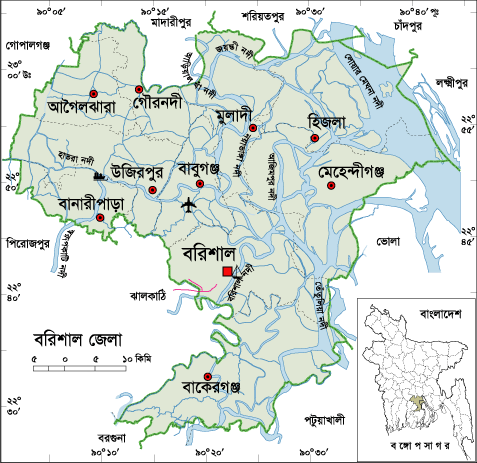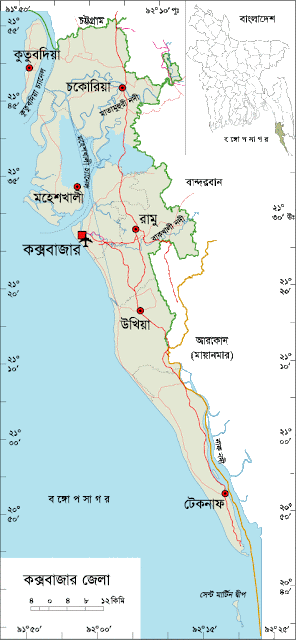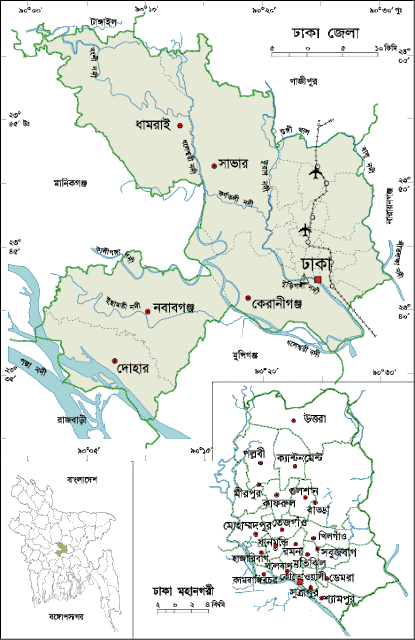About Bagerhat District, Bangladesh
Bagerhat district located in the south western part of Bangladesh. Bagerhat subdivision was turned into a district on 23 February 1984. The Geo position of the district is between 22˚32’ to 22˚56’ North latitudes and between 89˚32’ to 89˚48’ east longitude.
History of Bagerhat District
The history of Bagerhat district is very rich. The ancient name of the region was “Khalifatabad.” It is debatable about the naming of Bagerhat. Some historians think that the region is adjacent to Sundarban and the the region once under the raid of tigers (Bagh). So it is called “Bagher Hat.” By the passing of age the word Bagher- Hat turned into Bagerhat. Some researchers think that Bagerhat came from the name of “Baker Hat” that once sat on the northern part of Vhariab River. Some Historians think that the “Khalifa –e- Abad” established by Khan Jahan Ali (R) that Bag (garden) convert to Bagerhat by the passing of age. The name of great saint Khan Jahan Ali (R) is related to the history of Bagerhat. He migrated here in 1429 (debatable) with a number of followers from Delhi and established the Khalifabad Pargana covering areas including Bagerhat, Khulna, Satkhira, Jessore and Barisal. He ruled this pargana during the period from 1429 to 1449. After his death in 1449, Raja Prajapaditya conquered the Pargana. During the British East India Company Period, Bagerhat police station was established in 1842 under Khulna subdivision. The region was upgraded into subdivision under Jessore district in 1863. During the war of liberation in 1971 the Pakistani army entered Bagerhat on 21 April through the land way via Domer-pool. They killed about 200 innocent civilians at Khalishakhali and Babuganj. Many people were killed and wounded in encounters between the Pakistani army and the freedom fighters at Doyapara, Shakharikarihat and at Chakulia of Mollahat. Besides, 35 people were killed in an encounter between the freedom fighters and the Razakars (supporters of enemy army) in Morrelganj.
Bagerhat District Bordered By-
Bagerhat District is bordered by Faridpur district to the north, The Bay of Bengal to the south, Pirojpur, Barguna and a part of Gopalganjdistrict to the east, Khulna district to the west.
Why is Bagerhat District Famous For?
Bagerhat district has rich historical background. Bagerhat district is famous for Shat Gombuj Mosque, founded by Muslim saint Khan Jahan Ali.
Remarkable Personalities from Bagerhat district
The remarkable personalities from Bagerhat district are- Dr Nilima Ibrahim (Writer), Sree Das Gupta (Politician), Rudra Mohammad Shahidullah (Poet), Prof. Abdullah Abu Sayed (Writer and Social Worker), Prof. Abu Baker Shiddique, Sheikh Amjad Ali, Kiron Chandra Roy, A. S. M. Mostafizur Rahaman, Prof. Moazzem Hossain, Prof. Kazi Azhar Ali, Prof. Ruhul Amin, Dr Sheikh Gaus Mia, Bidhu Vushan Basu, Sheikh Kamruzzaman Tuku (Commander of Mujib Bahini) etc.
Tourist Attractions in Bagerhat District
Tourist Attractions in Bagerhat district are Shat Gambuj Mosque, Chandra Mahal, Graveyard and Lake of Khan Jahan Ali, Ghoradighi, Mongla Sea Port, Sundarban, Robart Morel Monument, Modhumala Temple and Lake, Buffalo Cultivation Centre, Panighata Lake, Sona Mosque, Ajoddha Temple, Shib Temple, Hiron Poient, Tagore Lake, Rampal Lake, Seven and Nine Tomb Mosque, Kodla Math, Durgapur Shiva Math, Mongla Sea Port etc.

Bagerhat District Administration
The area of Bagerhat is 3959.11 Sq Km. It is under Khulna Division. There are 03 Municipalities in Bagerhat named Bagerhat, Mongla and Moralgonj. The number of Upazilla (sub district) in Bagerhat district is 09, named- Bagerhat, Mollarhat, Fakirhat, Mongla, Kachua, Rampal, Sharankhola, Moralgonj and Chitalmari containing 76 Unions, 697 Mauzas and 1048 Villages.
Bagerhat District Population Data
The total population of Bagerhat district is 16,13,076 (Male- 802,314 and Female- 810,691), sex ratio 100:100, population density 407.40/Sq Km and annual growth rate is 0.79%. The literacy rate of Bagerhat district is 81.42%, school attendance rate is 87.70% for 5 to 24 years age group.
Other Important Data: The postal code of Bagerhat district is 9300 and NWD Code is 0468. Total Parliament seat in Bagerhat is 04. During the liberation war, Bagerhat was under Sector Number 08 & 09. Urbanization rate of the district is 13.23%.
Rivers in Bagerhat District
Rivers flow through Bagerhat district are Mongla, Modhumoti, Shila, Haringhata, Baleshari, Pathuria, Bangra, Daratana, Panguchi, Pashur, Vangra, Goshairkhali etc.
Agro Products from Bagerhat District
The main Agro products from Bagerhat District are- Paddy, jute, banana, coconut, betel Leaf, betel nut, peas, potato, watermelon, sugarcane, vegetables etc.


























